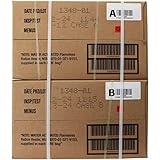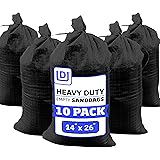Check Your Emergency Supplies
Gather Essential Items
Let me tell you, nothing is worse than being caught off guard during a winter storm. The first thing I always do is check my emergency supplies. You need the basics like food, water, and batteries. It’s like having your own mini survival kit ready to go!
My rule of thumb is to have at least three days’ worth of food and water. Canned goods, like soup and vegetables, are great because they have a long shelf life. And don’t forget snacks, especially if you’ve got kids — they can keep spirits high even in tough times.
Also, think about other supplies like a flashlight, a first aid kit, and those portable phone chargers. You never know when you’ll need to light things up or call for help, so be prepared!
Test Your Equipment
Now that you’ve got your supplies, it’s super important to test your equipment. Have you ever tried to light a flashlight only to find out the batteries are dead? Yeah, not fun. So, be sure you take some time to test everything before the storm hits.
Check your generator, if you have one. Make sure it’s in working order and you’ve got enough fuel. It’s amazing how much peace of mind it brings knowing that you’ve got backup power in case of an outage.
And how about that heater? If you rely on a space heater, give it a run to ensure there are no surprises when you really need it. Prepping gets you ahead of the game, trust me!
Make a Family Plan
Beyond gathering supplies, I always recommend sitting down with your family and making a winter storm plan. This makes your household’s response to a storm a lot more organized. It’s one of those things that might sound boring but is so essential.
Talk about where everyone should go if you lose power or get snowed in. You might decide to gather in one room to keep warm or head to a neighbor’s house if it’s safe. Also, have a communication plan in case someone is away during the storm.
== > What if ... Get a FREE Subscription to PREPARE
Try to involve everyone in the discussion—kids have great ideas too! This way, everyone knows what to expect and can stay calm when the weather goes awry.
Prepare Your Home
Insulate Your Home
Next up, let’s talk about insulating your home. I can’t stress enough how important this is! A well-insulated house keeps the warmth in and the chill out, which is just what you want when the temperature dips.
Check your windows and doors for drafts, and don’t shy away from using weather stripping or even heavy curtains. If you’re like me and hate the cold creeping in, you’ll appreciate this step when you’re cozy inside while the storm rages outside.
Also, consider advice from professionals about insulating your attic if you haven’t already. It really can help reduce utility bills and keep your house comfy during those chilly nights.
Clear Your Gutters
One thing that often gets overlooked is the gutters. Before the snow starts piling up, make sure your gutters are clear. I’ve learned the hard way that blocked gutters can cause ice dams, which lead to leaks and tons of water damage.
Grab a ladder (safely, of course) and clean out the leaves and debris. I usually set aside a Saturday for this chore because it not only helps in winter but is necessary for all seasons. It might be a little dirty, but think of it as a mini workout!
If you can’t manage this on your own, consider hiring someone. The last thing you need while snow is piling up is a leaky ceiling. Seriously, just pay the folks for their expertise!
Review Your Heating System
By now, you might have a lot on your winter prep list, but reviewing your heating system is critical. A broken furnace during a storm is a nightmare scenario that I’ve seen friends go through!
Make sure to schedule a maintenance check for your furnace. Replace filters and ensure ducts are clear and functioning properly. If you don’t have a maintenance agreement, now might be a great time to discuss it with a local technician.
And if your home runs on alternative sources, like propane or kerosene, check the levels! The last thing you want is to be out of heat because you didn’t fill a tank before the storm.
Stay Connected
Stay Informed with Weather Apps
Now, staying connected is so vital. In this day and age, having a good weather app can make a huge difference. I like to check a few different sources to get a sense of what’s going to hit my area. Knowledge is power!
Some apps will even send alerts for severe weather, so you can stay ahead of the game. Setting up these alerts can ensure you aren’t caught unaware, especially since storms can change rapidly.
And let’s be real, you don’t want to rely solely on TV or radio—what if the power goes out? Having that info on your phone is an absolute lifesaver, contributing to that peace of mind we all crave.
Get Preparedness and Self-Reliance Tips. Subscribe Now!
Communicate with Neighbors
Your neighbors can be a huge resource during storms. I always recommend checking in with them before a storm hits; share plans and let each other know if any needs arise. It’s all about building a community!
Some neighbors might have different supplies, like salt or shovels, and vice versa. Pooling resources can help everyone get through the storm with a little more ease and maybe even some laughs if the situation permits.
Plus, it fosters that good old neighborhood spirit. We’ve all had those nights where the snow has fallen, and we share hot cocoa while chatting about our preparations—it’s like an impromptu neighborhood gathering!
Keep Contact List Handy
Last but not least, having an emergency contact list is key. I can’t tell you how many times I’ve said, “Wait, what’s Aunt Mary’s number again?” Keep a physical copy of your contacts handy, along with local emergency services. You never know when you might need to reach out!
Make sure everyone in your household knows where to find the list, even better if you can have a digital backup on your phones. It’s all about being proactive and making sure you can reach out for help if needed.
Plus, if you have family members who might not have internet access, having that emergency list ensures they aren’t stranded without a way to contact someone to help.
Know When to Stay Put
Safety First
When a storm hits, I remind myself that safety is always the priority. If conditions are severe, it’s best to stay home and avoid driving. I appreciate a good snow day, but it’s crucial to know when it’s time to hunker down and ride it out.
Take a moment to assess conditions before you head out. Local authorities will often issue advisories about travel safety; always trust their advice. It’s not worth risking your life just to run an errand.
And if you’re ever in doubt, just stay put. Seriously, the world can wait until the storm passes, and you can enjoy the extra time at home!
Emergency Services and Plans
You should also familiarize yourself with local emergency services. If things get really hairy, knowing how to reach out for help can make a world of difference. Keep the contact information for your local police, fire department, and emergency medical services handy.
The last thing you want is to be panicking in an emergency and wasting precious time trying to find a number. I’ve learned it’s better to be overprepared than underprepared.
Additionally, your neighbors can be great allies in an emergency. Maybe set up a plan to check on one another to ensure everyone is safe, especially the elderly and those with mobility issues. Community is everything when it comes to weathering storms!
Remain Calm and Collected
Finally, if a storm hits, focusing on staying calm is essential. I know it sounds easier said than done, especially when the winds start howling, but panicking never helped anyone!
Make sure all members of your family know the plan and what to expect. Play games or read together to keep anxiety at bay. It’s a great way to bond while also distracting from the dreadful weather outside.
Just remember to breathe, take it one step at a time, and trust that you have prepared well. Staying calm will help boost everyone’s morale and make the experience a little bit easier for all involved.
FAQs
1. What should I include in my emergency supplies for a winter storm?
Ensure you have non-perishable food, water for at least three days, batteries, a flashlight, a first aid kit, and any medications you may need.
2. How can I check if my heating system is ready for winter?
You should schedule a maintenance check for your furnace, replace filters, and inspect ducts to ensure everything is functioning properly.
3. What’s an effective way to keep warm during a winter storm?
Staying insulated is key. Use heavy curtains, seal drafts in windows and doors, and gather in one room to conserve heat with blankets.
4. How do I stay informed during a winter storm?
Download weather apps that provide alerts for severe weather and check multiple trustworthy sources for updates on impending storms.
5. What is the best way to communicate with my neighbors during a storm?
It’s great to check in before the storm hits. Share plans, pool resources, and establish a way to contact each other in case someone needs help.






